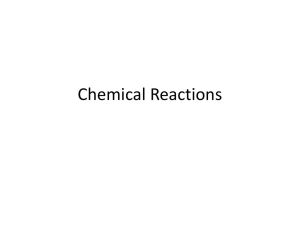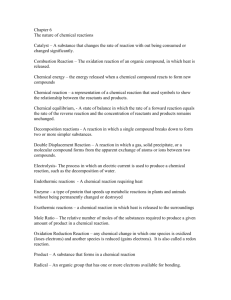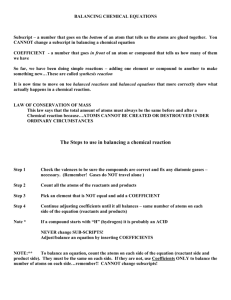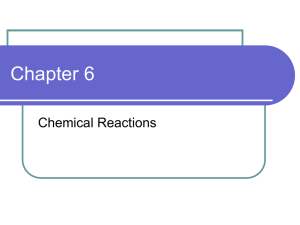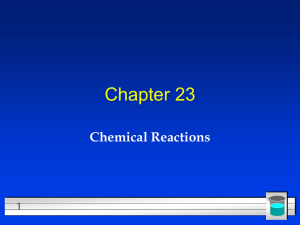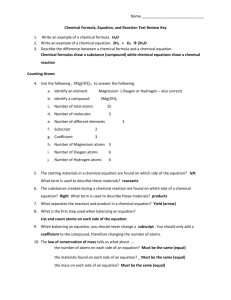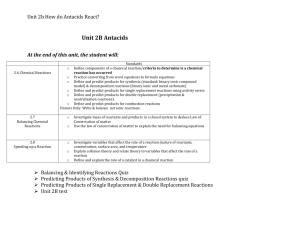Chapter 5 Chemical Reactions
advertisement
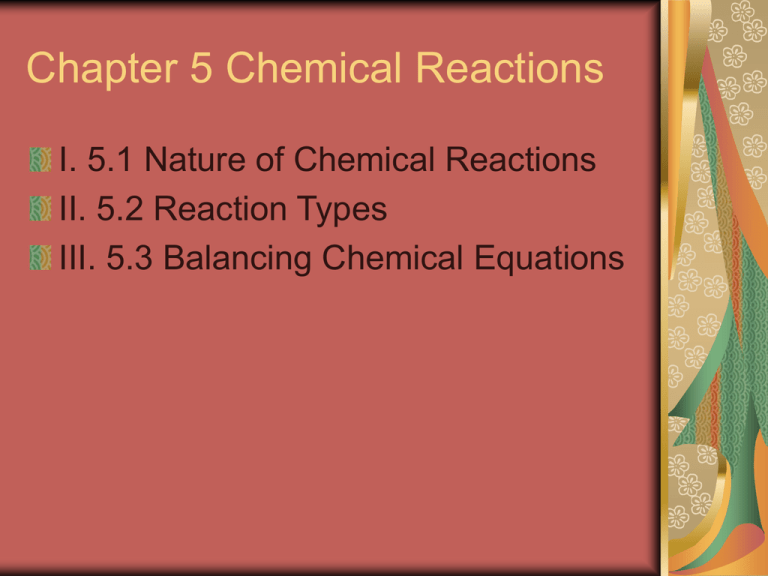
Chapter 5 Chemical Reactions I. 5.1 Nature of Chemical Reactions II. 5.2 Reaction Types III. 5.3 Balancing Chemical Equations I. 5.1 Nature of Chemical Reactions A. Signs of a chemical reaction 1. bubbles are given off 2. changes in color 3. precipitates are formed 4. energy is released or absorbed B. Chemical reactions rearrange atoms 1. Reactants - a substance that undergoes a chemical change a. bonds are broken b. energy is added in the form of – – – – (1) heat (2) electricity (3) sound (4) light 2. Products - a substance that is the result of a chemical reaction a. bonds are formed b. energy is released in the form of – (1) heat – (2) light – (3) sound 3. Reactions can be referred to as a. Exothermic - a reaction that transfers energy from the reactants to the surroundings usually as heat b. Endothermic - a reaction in which energy is transferred to the reactants usually as heat from the surroundings II. 5.2 Reaction Types A. Classifying Reactions 1. We use patterns to identify the general types of chemical reactions a. Synthesis reactions – (1) a reaction of at least two substances that form a new, more complex compound – (2) general form » (a) A + B g AB » (b) 2 Na + Cl2 g 2 Na Cl » i) subscript indicates the number of atoms per molecule » ii) coefficients indicates the number of molecules » iii) g is read as yields b. Decomposition Reactions – (1) a reaction in which one compound breaks into at least two products – (2) general form » (a) AB g A + B » (b) 2 H2O g 2 H2 + O2 – (3) electrolysis is the decomposition of a compound by an electric current c. Single Replacement (displacement) Reactions – (1) a reaction in which atoms of one element take the place of atoms of another element in a compound – (2) general form » (a) XA + B g BA + X » (b) 3 CuCl2 + 2 Al g 2 AlCl3 + 3 Cu – (3) combustion a reaction in which a compound and oxygen burn » (a) 2 CH4 + 4 O2 g 2 CO2 + 4 H2O d. Double Replacement (displacement) Reactions – (1) a reaction in which a gas, a solid precipitate, or a molecular compound is formed from the apparent exchange of ions between two compounds – (2) general form » (a) AX + BY g AY + BX » (b) Pb(NO3)2 + K2CrO4 g PbCrO4 + 2 KNO3 e. Reduction/Oxidation (redox) reaction is a reaction that occurs when electrons are transferred from one reactant to another. – (1) reduced - substance that accept electrons – (2) oxidized - substance that gives up electrons III. 5.3 Balancing Chemical Equations A. Four Steps for Balancing Chemical Equations 1. Determine the type of reaction. a. D - Decomposition b. S - Synthesis c. SR - Single Replacement d. DR - Double Replacement 2. Recombine ions/atoms on the product side. a. different free elements and different compounds 3. Balance compounds on the product side a. using subscripts b. check for diatomic elements – (1) only for Decomposition and Single Replacement reactions 4. Balance equation by placing coefficients in front of each compound or free element where necessary a. Conservation of matter b. must have the same number of atoms for each element on both sides of the equation 5. Examples a. Mg + O2 g S 2 Mg + O2 g 2 MgO b. Pb(NO3)2 + KI g DR Pb(NO3)2 + 2 KI g PbI2 + 2 KNO3 c. N2 + H2 g d. NaCl g
